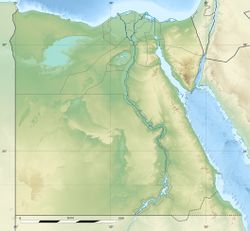زلزال الشرق الأدنى 1068
| التاريخ المحلي | 18 مارس 1068 [1] |
|---|---|
| التوقيت المحلي | الصباح |
| المقدار | ≥ 7.0 [2] |
| المركز | 29°30′N 34°57′E / 29.5°N 34.95°E [3] |
| المناطق المتأثرة | Near East |
| إجمالي الضرر | Extreme [3] |
| أقصى شدة | IX (عنيف) [3] |
| الخسائر | ~ 20,000 [1] |
زلزال الشرق الأدنى 1068 وقع صبيحة 18 مارس في الشرق الأدنى بطول الجزء الجنوبي من نظام فوالق صدع البحر الميت. الحدث كان مسئولاً عن وفاة ما يُقدر بنحو 20,000 شخص وتسبب بأضرار فادحة في مصر والجزيرة العربية ومناطق أخرى في شرق المتوسط. زلازل قوية أخرى في نفس الجزء الجنوبي من صدع البحر الميت أثرت على المنطقة.
الملابسات الجيولوجية
صدع البحر الميت هو فالق صدع طوله 1000 كيلومتر يمتد من البحر الميت في الجنوب إلى فالق شرق الأناضول في تركيا شمالاً. الامتداد الجنوبي للصدع يُعرف بإسم "فالق وادي عربة" (على اسم وادي عربة). هذا الجزء من الصدع يجري من 160 كم شمال العقبة إلى جنوب البحر الميت بمعدل انزلاق 4 ±2 مم في السنة.[4]
الآثار
آثار الزلزال كانت بادية عن بعد من بانياس (على الساحل السوري) إلى منطقة الحجاز في ما هو اليوم السعودية. The ancient city of Ayla, located at the northern end of the خليج العقبة حيث توجد اليوم مدينة العقبة، was destroyed. Paleoseismic investigations have revealed more than 12 كيلومتر (7.5 mi) of fault rupture, beginning just north of Eilat, that were dated between 900 and 1,000 years before present. A magnitude of at least 7.0 was presented based on the reported damage and the extent of the observed fault breaks.[2]
Alarm was caused at Saint Catherine's Monastery on the Sinai Peninsula, and there was damage in the ancient city of Tinnis, but not farther to the west along the Egyptian coast in Alexandria. In Cairo the only damage was to a corner of the Mosque of Amr ibn al-As in Fustat. Seismologist Nicholas Ambraseys described one account of the effects at Ramallah as destructive and with a large loss of life (15,000 deaths, several hundred of which were boys at a school). He also expanded on the effects to the north in Banyas, where 100 were killed, and in Jerusalem, where the roof of the Dome of the Rock was "displaced and then returned to its former position". Those that were affected by the heavy damage in Ramallah apparently migrated to Jerusalem, which indicated to Ambraseys that the effects there were otherwise minimal.[5]
أحداث أخرى
In addition to the event in 1068, the southern portion of the DST has experienced three other historical events (all having an estimated magnitude of 6.5–7.0) with two in the northern section near the Dead Sea, and one closer to Aqaba. The event in 1212 caused significant damage to towns in the Arabah Valley as well as the destruction of a church on the Sinai Peninsula. In 1293, near the southern portion of the Dead Sea, an earthquake destroyed three towers of a castle and caused damage between the Dead Sea and Gaza. In 1458, another event again affected the southern Dead Sea area, this time causing a 2.2 m (7 ft 3 in) left-lateral offset at the Tilah Castle. The castle was built across the fault during Roman or Byzantine times and the building that housed the water tank sustained the displacement.[4]
انظر أيضاً
المراجع
- ^ أ ب Abdel Fattah, Ali K.; Hussein, Hesham M.; Ibrahim, Ezzeldien M.; Abu El Atta, Ahmad S. (1997), "Fault plane solutions of the 1993 and 1995 Gulf of Aqaba earthquakes and their tectonic implications", Annali di Geofisica (Istituto Nazionale Geofisica e Vulcanologia) XL (6): 1557, http://www.annalsofgeophysics.eu/index.php/annals/article/view/3831
- ^ أ ب Klinger, Y.; Avoua, J. P.; Dorbath, L.; Abou Karaki, N.; Tisnerat, N. (2000), "Seismic behaviour of the Dead Sea fault along the Araba valley, Jordan", Geophysical Journal International (Wiley-Blackwell) 142 (3): 772, doi:, http://www.ipgp.fr/~klinger/page_web/NewFiles/YK_gb.html
- ^ أ ب ت National Geophysical Data Center / World Data Service (NGDC/WDS), Significant Earthquake Database, National Geophysical Data Center, NOAA, doi:, https://www.ngdc.noaa.gov/nndc/struts/form?t=101650&s=1&d=1
- ^ أ ب Yeats, R. (2012), Active Faults of the World, Cambridge University Press, pp. 293, 294, 296, ISBN 978-0521190855, https://books.google.com/books?id=aQUgAwAAQBAJ
- ^ Ambraseys, N. N.; Melville, C. P.; Adams, R. D. (2005), The Seismicity of Egypt, Arabia and the Red Sea: A Historical Review, Cambridge University Press, pp. 30, 31, 101, ISBN 978-0-521-02025-1, https://books.google.com/books?id=fxnnk2inWT0C&pg=PA31
